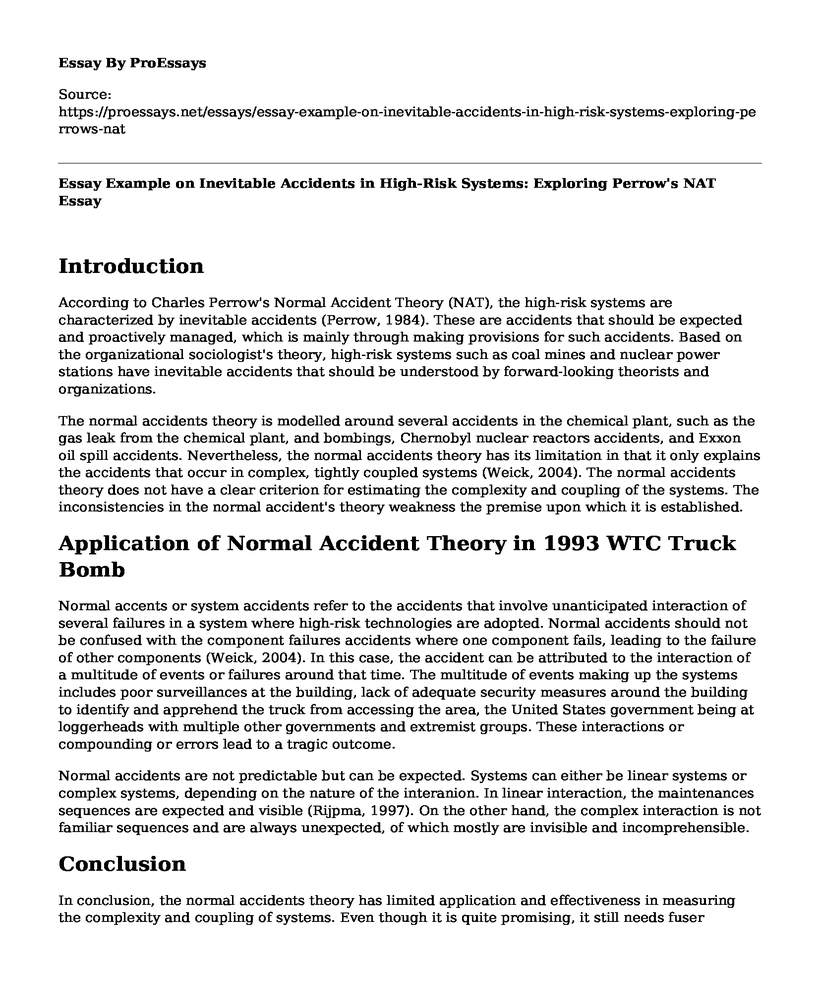Introduction
According to Charles Perrow's Normal Accident Theory (NAT), the high-risk systems are characterized by inevitable accidents (Perrow, 1984). These are accidents that should be expected and proactively managed, which is mainly through making provisions for such accidents. Based on the organizational sociologist's theory, high-risk systems such as coal mines and nuclear power stations have inevitable accidents that should be understood by forward-looking theorists and organizations.
The normal accidents theory is modelled around several accidents in the chemical plant, such as the gas leak from the chemical plant, and bombings, Chernobyl nuclear reactors accidents, and Exxon oil spill accidents. Nevertheless, the normal accidents theory has its limitation in that it only explains the accidents that occur in complex, tightly coupled systems (Weick, 2004). The normal accidents theory does not have a clear criterion for estimating the complexity and coupling of the systems. The inconsistencies in the normal accident's theory weakness the premise upon which it is established.
Application of Normal Accident Theory in 1993 WTC Truck Bomb
Normal accents or system accidents refer to the accidents that involve unanticipated interaction of several failures in a system where high-risk technologies are adopted. Normal accidents should not be confused with the component failures accidents where one component fails, leading to the failure of other components (Weick, 2004). In this case, the accident can be attributed to the interaction of a multitude of events or failures around that time. The multitude of events making up the systems includes poor surveillances at the building, lack of adequate security measures around the building to identify and apprehend the truck from accessing the area, the United States government being at loggerheads with multiple other governments and extremist groups. These interactions or compounding or errors lead to a tragic outcome.
Normal accidents are not predictable but can be expected. Systems can either be linear systems or complex systems, depending on the nature of the interanion. In linear interaction, the maintenances sequences are expected and visible (Rijpma, 1997). On the other hand, the complex interaction is not familiar sequences and are always unexpected, of which mostly are invisible and incomprehensible.
Conclusion
In conclusion, the normal accidents theory has limited application and effectiveness in measuring the complexity and coupling of systems. Even though it is quite promising, it still needs fuser development because most of the accents recorded were because of simple or complex component failures and not system accidents. Normal accidents oil still in the rudimentary state and cannot be used to model accidents with high accuracy.
References
Perrow, C. (1984). Normal Accidents: Living with High-Risk Technologies (1st ed.). New York, New York, United States: Basic Books.
Rijpma, J. (1997). Complexity, Tight-Coupling, and Reliability: Connecting Normal Accidents Theory and High-Reliability Theory. Journal of Contingencies and Crisis Management, 5(1), 15-23. DOI: 10.1111/1468-5973.00033
Weick, K. (2004). Normal Accident Theory as Frame, Link, and Provocation. Organization & Environment, 17(1), 27-31. DOI: 10.1177/1086026603262031
Cite this page
Essay Example on Inevitable Accidents in High-Risk Systems: Exploring Perrow's NAT. (2023, Mar 26). Retrieved from https://proessays.net/essays/essay-example-on-inevitable-accidents-in-high-risk-systems-exploring-perrows-nat
If you are the original author of this essay and no longer wish to have it published on the ProEssays website, please click below to request its removal:
- Production and Sale of Tobacco Must be Made Illegal - Argumentative Essay
- Tim Hortons Company Analysis Paper Example
- Essay Sample on Corporate Cultures
- Essay Sample on Embracing Diversity in Management
- Paper Example on Staying Healthy: Achieving Optimal Wellbeing Through Diet & Sleep
- Achieving Success Through Effective Decision-Making: Research Paper on Corporate Strategy
- Essay Example on Victoria's Secret: Pioneering US Lingerie, Clothing & Beauty Retailer







